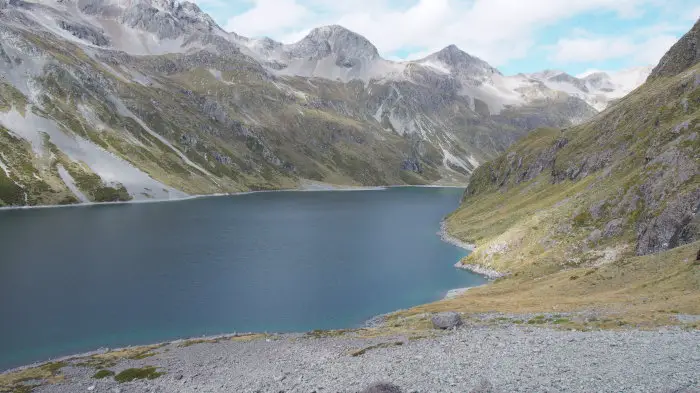Welcome to my guide to targeting rainbow trout in mountain lakes. I love fishing in the mountains, there is nothing better than fishing surrounded by nature. Maybe best of all, mountain lakes usually stay cold enough to fish even in the hottest part of summer.
Many new anglers can find lakes a bit daunting. There is simply so much water to cover. Where to even start looking for trout. Well in this guide, I hope to cover the basics on where to find trout and will give some hints on what tackle generally works well.
Where to find Rainbow trout in mountain lakes?
Rainbow Trout do travel throughout the lake. It is not uncommon for them to swim over a mile over the course of the day. Some fish even change sides with quite some frequency.
The rainbows move around for two main purposes, to search for food and to migrate to their spawning grounds.
The main reason why rainbow trout move around is to search for food. If you can find the food, you will find trout. In the fall and spring Rainbow trout feed close to shore, spending most of their time in the littoral zone, that is the area of the lake that is close to shore and penetrable by sunlight.
In the summer, they move offshore, probably to feed on plankton or shoals of baitfish. This offshore movement typically coincides with the warming of inshore water temperatures, and the corresponding changes in food availability. If you have access to a boat, the summer months is the time for targeting trout over deeper water.
While Rainbow trout might swim across the deepest parts of the lakes, they usually remain within a few yards of the surface. Only occasionally do they dive deeper in search of food or refuge which usually take place from dawn and throughout the morning.
In the winter, if not on a spawning run. The lake Rainbows split their time between deeper water at night, before moving onto shallow flats to feed during the day.
I also need to cover the spawn, depending on temperature. Sometime late in the winter, to early spring. Many of the rainbow trout will start to migrate out of the lake in search of spawning grounds. Before leaving the lake, they often gather near the mouths of streams and rivers, only pushing upstream when increase of flow allows. I know many anglers, who target rainbow trout as they gather at the mouth to spawn.
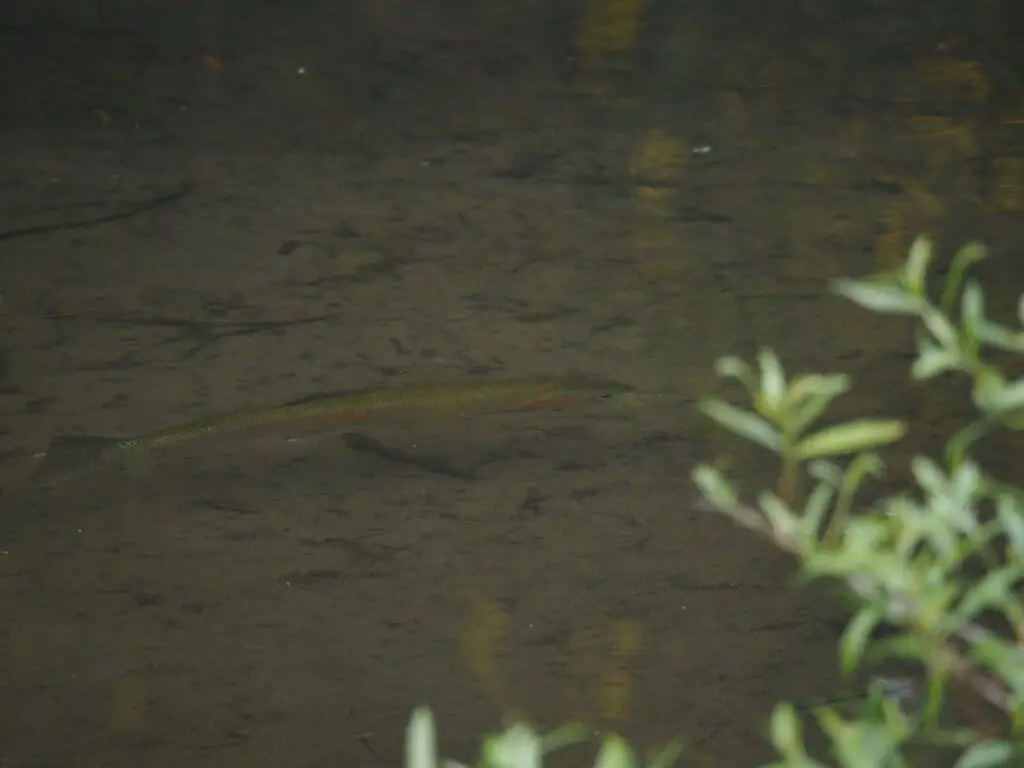
Best areas to target include.
– Shallows and flats, The shoreline and shallow flats are a prime locations to find trout. In mountain lakes trout seek out the shallows because it is the warmest part of the lake. There it takes less energy to feed, plus the warmth and light of the sun simulate aquatic life which the trout feed upon. This habitat is not only home for juvenile trout, but are one of the main areas where larger rainbows can be found.
– Weed banks. Weedbanks is another feature of the shoreline ecosystem. They are like a buffer of food for the trout. Weedbanks are often rich with numerous snails, crustaceans, baitfish and countless varieties of insects. Weedbanks can hold rainbow throughout the year, but I feel they are at their best in the fall.
– Stream inlets and outlets. Rainbow trout love moving water for several reasons. Firstly it is more oxygenated, although that is not really a worry in cool alpine conditions. But best of all, the current carries the food to the trout. They do not have to spend money chasing after meals.
Stream mouths are a good place to drift a streamer or minnow imitation down current. In the winter, spawning rainbow also gather there before pushing their way upstream to spawn.
I am now going to discuss several mountain lakes and highlight the areas more likely to hold feeding trout.
Lake A
This alpine lake in the Colorado mountains holds a population of rainbow trout.
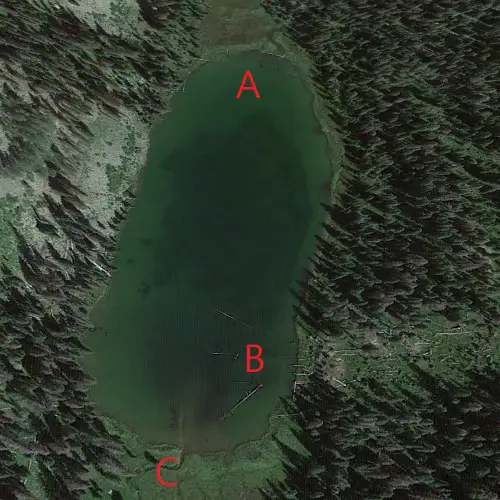
Such lakes fish best in the Summer and Fall. They freeze over during the winter and there is a small and reel risk from avalanches that time of year.
This lakes has a large littoral zone, and plenty of shallow water which is the ideal habitat for feeding rainbows. I will now break down the key features.
- Site A Marks the inlet stream. Rainbows love current so they will likely concentrate around the inflow. In the spring, they will likely head in that direction to spawn.
- Site B Is an old avalanche path. The Avalanche pushed several trees out into the lake creating an excellent cover for the rainbow trout. This is where the rainbows will likely rest before moving into other areas of the lake to feed.
- Site C is the outlet. Its proximity to the sunken trees will make it an ideal location for trout to feed. Because it is so small, any trout there will be easy to spook. For best success, try and fish it first thing in the morning before any other angler disturbs the area.
Lake B
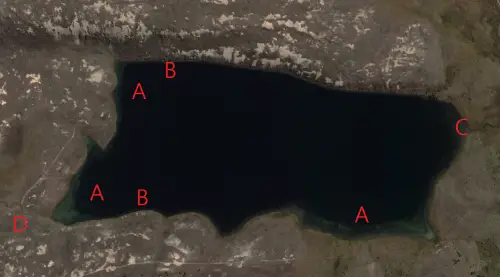
Lake B is much deeper. This lake holds predominantly brown trout, but for the purpose of this article I will discuss it’s features and how they relate to rainbow trout.
The northern shoreline is steep, almost a cliff leading into the lake. While the slopes on the other three sides are much more gradual often leading into a shallow.
- Site A marks the shallows. These are the first part of the lake which starts to warm in the spring, and the area of the lake floor which receive the most sunlight which generates grow of aquatic life. The shallows can hold trout year round, but I feel they are at their best late spring into the early summer. The rainbows have returned from spawning so are feeding hard to regain lost condition.
- Site B represents deeper water close to shore. This marks the likely spot weed banks will grow close to shore. There the water is deep enough to protect the plants from dabbling birds but shallow enough to get plenty of light. The weedbeds, normally fish best over the summer and into the fall.
- Site C is the outlet stream. Trout love to feed in current, so they seek it out any chance they get, If you look carefully, this lake does not have an inlet. In all but the heaviest of rains the water basically oozes through the marshy shoreline.
- Site D does not contain rainbow trout, but it marks the main access track. This is where 99% of anglers start fishing. It is also the part of the lake that sees by far the most pressure. I generally find the best fishing is well away from the main access points. The trout are less pressured so less likely to spook. I only fish near the access point if I am the first angler of the day to reach the lake.
When are Rainbow trout most active in mountain lakes?
Rainbow trout are most active in the morning, with a slight peak at dawn. They are much less active at night. . This is in quite a sharp contrast with Brown trout which predominately feed during the hours of darkness. This difference in feeding habits might be due to Rainbows being primarily visual feeders, while brown trout have a much better ability to sense prey through their lateral line.
After the spring thaw and through the summer and fall Rainbow trout spend the majority of their time in the top 3 yards of the water column, with the occasional shallow dive mostly at dawn and during the day. In bright sunny weather, they do seek slightly deeper water.
During the summer, the Rainbows often feed upon plankton during the day. That is when the plankton rises close to the surface in search of sunlight.
During the winter, when the water temperatures are at their coldest. Rainbows can be slow to start feeding in the morning, they rather rest up and wait until the late afternoon before searching for prey.
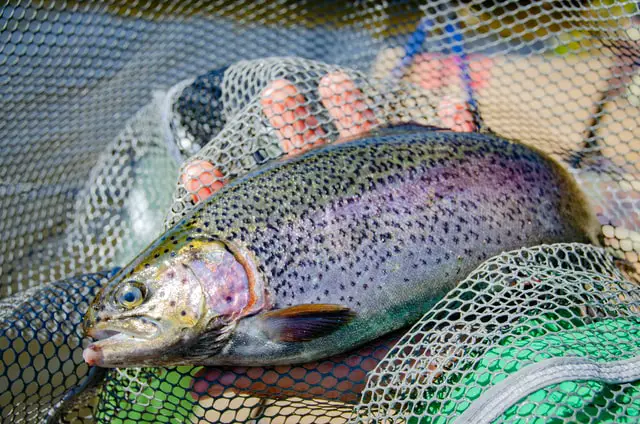
Spinning for trout in Mountain lakes.
Spinning is a fun and easy way to catch rainbow trout in alpine lakes and ponds. A lot of water can be fished very quickly.
The biggest suggestion I can make is to use lightweight tackle. Do not use line heavier than 6lb or 0.009”, ideally look for line with a diameter under 0.008”. Mountain lakes are typically very clear, and while the trout might not see the line they certainly can sense something is there which can cause them not to strike.
I also like to use smaller size spinners and lure imitations. One of my favorite tactics is to work the shallows, and weed banks with a small F05 Rapala. They can be tricky to cast, but the trout are usually feeding quite close to shore.
I have mixed thoughts with regards to inline spinners. They are an excellent choice for fishing streams and rivers where there are a lot of sounds to distract the trout, but sometimes I feel they are a bit loud when lake fishing, and the vibration can actually turn fish off.
When the weather is windy. I get out my casting spoons. One of the best casting lures is the Acme Kastmasters, it can really punch into the wind and is easy to retrieve. But, I often like my spoons to behave a little more action and flutter, which is why I often reach for a Krocodile or Thomas Speedy shiner instead.
The Australian made Tasmanian Devil’s lures also work well and in most parts of the world, they are rarely fished. So they have a bit of a unique factor going in their advantage.. I am a big believer that trout start to recognize commonly fished patterns.
When the trout are being very fussy feeders, I like to trail a ‘streamer fly’ behind a casting spoon. The big flashy spoon gets the trout’s attention, but they often decide not to strike, but rather than wasting energy, they smash the trailing fly instead.
Fly fishing in mountain lakes
When conditions are perfectly calm, and the water gin clear there is no better way to fish a pristine alpine lake than with the fly rod.
I know many anglers prefer to target the rivers and streams, but for me. Nothing is more enjoyable and rewarding than working the shoreline of mountain lakes. In some ways, I fish the shoreline of the lake like it is a river. I ignore the vastness of the middle and concentrate on the edges.
I approach the lake with stealth and calmness, I keep a low profile and do my best not to cast a shadow across the water. I move slowly and scan the water. I prefer to sight my fish before casting, and I wait until they are swimming away before casting.
It is important to use the shoreline to your advantage, I will climb up the bank to get a better view, or stand behind scrub or reeds to conceal my profile. I do not want the trout to know that I am there.
I nearly always fish a nymph suspended beneath a dry fly. I find the allure of the dry, is enough to bring trout off the bottom, and on the way up, or back down they usually grab the nymph even if they reject the dry.
The exact dry fly and nymph to use does vary with the location. My personal preference in the spring is a mayfly imitation. I typically use a Royal Wulff or Parachute Adams in #12-#18. Both are classic, proven patterns. There is no need to reinvent the wheel.
In the summer, I often reach for a black gnat as an indicator, around #10-#14. It represents a small fly or other bugs.
My nymphs of choice are also traditional patterns such as pheasant tails or hare ears. Depending on the lake, and how much pressure the fish are under I like to use a #12-#16 nymph. In some highly pressured waters, I will go smaller.
I do not lake fish with streamers often. But when I do, I prefer to use a large woolly bugger or rabbit strip fly. Usually somewhere between #6-#12 in size. If I do decide to fish a streamer, it is nearly always at a river mouth where I use the current to my advantage.

